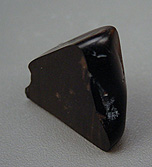

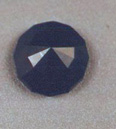
If you were to visit some of the many English websites devoted to this gem you would begin to realize, first, what a long history of use the gem has in the British Isles, and in the World, and second, how passionately some individuals feel about this lesser known gemstone.
Jet, an opaque black, organic gem is usually described as a form of fossilized wood, but not in the sense of "petrified" wood, where the orginal cellular structure has been replaced by minerals and preserved. Jet is essentially a form of lignite coal, having its origin in buried wood from ancient forests, but much modified over millions of years by compression and heating deep underground. Occasionally you find the term "black amber" applied to jet, but that name is neither geologically nor gemologically accurate and must be considered a misnomer. Perhaps the name arose due to the fact that, like amber, jet will develop a static electrical charge when rubbed.
One of the earliest of mankind's ornaments, jet beads have been unearthed from burial sites dating to the Bronze Age. The extension of the Roman Empire into the British Isles resulted in this black gem's use in the jewelry and art objects of rich Romans. Besides ornamental use, there are written records showing that powdered jet was used as a medication by the physicians of the 17th Century.
The height of jet popularity was during the Victorian era. Upon her widowhood, Queen Victoria began wearing "mourning jewelry", primarily of jet, and continued to do so throughout her long life. The public emulated their Monarch, so that earrings, brooches and pendants were produced in large quantities and varying qualities and worn by everyone who could afford them. By the 1870s the gem had reached its peak of use and, until quite recently, has been in a consistent decline in its popularity ever since. Some speculate that the gem's association with death, mourning and sadness is responsible.
Recently, signs of renewed popularity have been seen, perhaps as part of the general revival of interest in Victorian jewelry, or maybe due to its credentials as a gem with "metaphysical" attritubes and uses.



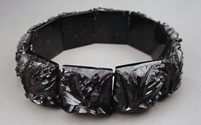
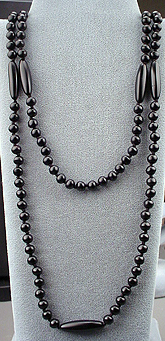
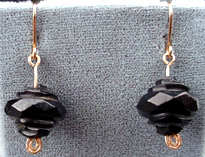
Although there are known deposits of jet in many parts of the world, such as the USA (Utah, Colorado, New Mexico), Spain and the Middle East, historically, the premier site is along the Yorkshire coast, near the town of Whitby in England. Deposits there occur in shale beds which form cliffs along the beach and which extend under the sea. During the height of its popularity it was mined, but both before and after that period, a sufficient supply is picked from "land slides" and collected from material washed up on the beaches.
Jet is soft (hardness ranging from 2.5 to 4) and somewhat brittle. Jet jewelry shouldn't be cleaned in an ultrasonic or with steam. It can be washed with warm soapy water and a soft brush, and a small amount of mineral oil applied to the surface will revive the shine.
Simulants such as bog oak, "French Jet" glass, ebony wood, dyed horn, early and modern plastics and a rubber-like material called "vulcanite" are seen in the marketplace. One sure way to verify natural jet is to touch an inconpicuous part of the piece with a red hot needle and smell the results -- only jet will smell like burning coal.
Even the best quality jet is modestly priced as a raw material. Most of the value of jet is associated with the artistry of carving or the historical context of the jewelry or ornamental piece. The finest pieces have a smooth, well polished surface that is free of cracks and blemishes.
Gemological Properties:
Toughness: poor